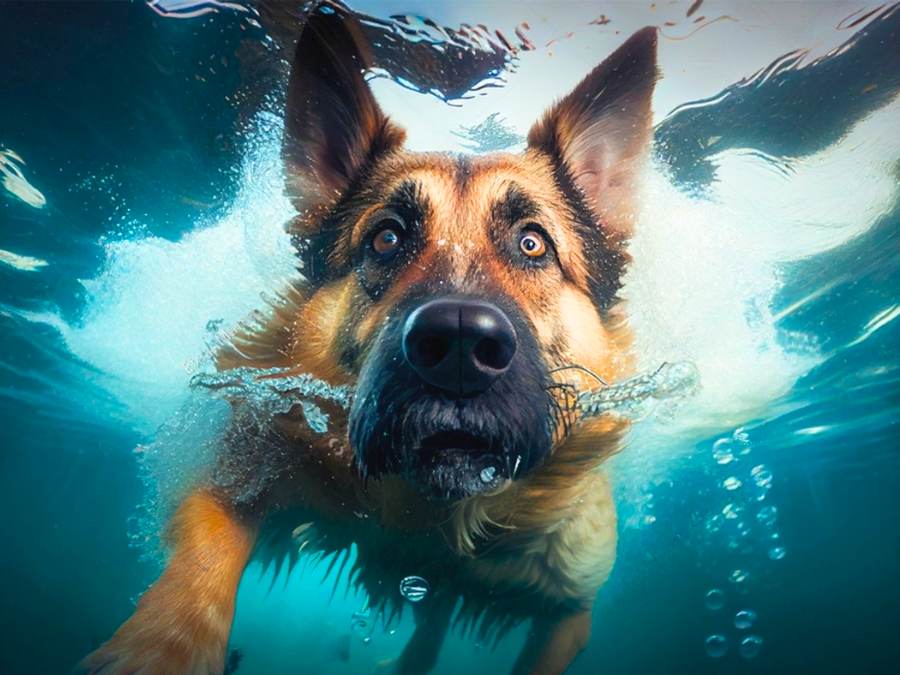Yes, German Shepherds can swim. However, it’s important to note that while the breed has a natural ability to swim, individual dogs may vary in their affinity for water. Some may take to it naturally and enjoy swimming, while others may be hesitant or even afraid of water.
In this comprehensive guide, we will dive into the aquatic abilities of German Shepherds, provide tips for safely introducing them to swimming, and explore how this activity can benefit both their physical health and mental well-being.
Are German Shepherds Natural Swimmers?
German Shepherds have a natural ability to swim, like many dog breeds, but whether they take to water and how well they swim can vary widely among individual dogs.
They are not born swimmers but possess physical attributes and a level of intelligence that can make them adept at swimming when properly introduced to it.
German Shepherds are known for their strength, endurance, and versatility, which can make them good swimmers once they are comfortable and familiar with water.
However, swimming is a learned skill for them, just as it is for most dogs. Some German Shepherds may jump into the water and swim naturally with little hesitation, while others might be apprehensive and require a gradual introduction to feel comfortable in the water.
How Fast Can a German Shepherd Swim?
German Shepherds can swim at speeds of around 1-2 miles per hour (1.6-3.2 kilometers per hour).
Older German Shepherds will probably swim slower while, those that are more athletic and have been trained for swimming or water rescue, might reach the higher end of this range or possibly exceed it slightly.
How Long Can a German Shepherd Swim?
A healthy, active German Shepherd with a positive association with water might be able to swim for 10 to 30 minutes, or possibly longer, in a single session.
Age plays a significant role, as younger dogs often have more stamina, whereas older dogs may tire more quickly.
Additionally, the conditions of the water, including its temperature and the presence of currents, can impact a dog’s endurance.

Physical Characteristics that Help German Shepherds Swim
German Shepherds possess several physical characteristics that aid in their ability to swim.
- Coat: They have a double coat that provides insulation against cold water, helping them maintain body temperature during swimming.
- Long snout: The long snout facilitates efficient breathing by keeping the nose above water, which is especially beneficial during extended swimming sessions or in choppy waters.
- Strong back legs: Their strong back legs offer powerful propulsion, allowing for efficient paddling and helping them to swim faster and with more stability.
- Webbed paws: German Shepherds have slight webbing between their toes, which acts like flippers to aid in swimming, providing them with additional thrust and making paddling more effective.
- Tail: Their tail serves as a rudder, helping to steer and maintain balance in the water, which is crucial for directional control and agility during swimming.
- Strong body: The overall strong and muscular body of a German Shepherd contributes to their swimming ability, offering endurance and the physical strength required to swim effectively.
These characteristics combined make German Shepherds capable swimmers, with the potential to enjoy and excel in water-based activities.
RELATED: Do German Shepherds Like Water?
Can German Shepherds Swim in Cold Water?
Yes, German Shepherds can swim in cold water. However, like all dogs, they are susceptible to the dangers of cold water, which can pose significant health risks.
According to AKC, the water temperature plus the air temperature should equal at least 100 degrees Fahrenheit (38 degrees Celsius) before letting your dog swim.
As a general rule of thumb, if the water feels too cold for you to stand or wade in, it’s likely too cold for your German Shepherd.
At temperatures lower than 50 degrees Fahrenheit (10 degrees Celsius), the risk of hypothermia and frostbite increases significantly, even with GSD’s protective coat. Water conducts heat away from the body much faster than air, making cold water particularly dangerous.
According to some sources, the most comfortable temperature for your GSD to swim is 45 degrees Fahrenheit (21 degrees Celsius).
When considering water activities with your German Shepherd in colder environments, always assess the water temperature first and observe your dog’s behavior and condition closely if you decide to proceed.
Signs of discomfort or distress should be taken seriously, and you should remove your dog from the water immediately.

How to Teach My German Shepherd to Swim?
Here’s a step-by-step guide on how to teach your German Shepherd to swim, focusing on safety, patience, and positive reinforcement.
Step 1: Introduce Water Gradually
- Start with shallow water: Begin in a shallow area where your dog can comfortably stand. This could be a shallow end of a pool, a calm lake, or a kiddie pool in your yard.
- Make it positive: Use toys or treats to make the experience fun. Encourage and praise your dog for interacting with the water.
Step 2: Use a Life Jacket
- Invest in a dog life jacket: A life jacket can provide buoyancy and make your dog feel more secure. Ensure it fits properly, offering support without restricting movement.
- Familiarization: Let your dog wear the life jacket before getting into the water to get used to the feel of it.
Step 3: Enter the Water Together
- Lead by example: If possible, go into the water first and encourage your dog to follow. Dogs are often more willing to try something new if their owner is participating.
- Stay close: Remain close to provide physical support and emotional reassurance. Use a leash if necessary for added control and security.
Step 4: Encourage Paddling
- Support their body: Initially, support your dog’s belly to help them feel buoyant and encourage them to paddle with their legs. Gradually reduce support as they become more confident.
- Use toys and games: Motivate them to move in the water by using floating toys or playing games.
Step 5: Practice and Build Confidence
- Short, positive sessions: Keep training sessions short and positive. Avoid overexertion and end on a high note with lots of praise.
- Gradually increase depth: As your dog becomes more comfortable, gradually move to deeper water where they have to swim rather than walk.
Step 6: Teach Swimming Skills
- Practice direction and control: Teach your dog to follow commands in the water, such as coming to you, turning, and stopping. This enhances safety and enjoyment.
- Build endurance: Gradually increase the length of swimming sessions to build your dog’s endurance and strength in the water.
Safety Tips
- Never leave your dog unattended: Always supervise your dog closely when they are in or near water.
- Rinse off after swimming: Rinse your dog to remove chlorine, salt, or natural water residues that could irritate their skin or coat.
- Watch for signs of fatigue: Be vigilant for signs of tiredness or distress and let your dog rest as needed.
- Check water conditions: Ensure the swimming area is safe, free of strong currents, deep undercurrents, or hazardous objects.
Teaching your German Shepherd to swim requires patience, encouragement, and attention to safety. Every dog learns at their own pace, so it’s important to progress at a rate that’s comfortable for your dog, ensuring that each step is a positive experience.

When Should You Not Let Your German Shepherd Swim?
There are several circumstances under which you should not let your German Shepherd swim, primarily concerning the dog’s health, safety, and environmental conditions.
- Health issues: Do not let your German Shepherd swim if they have health problems, especially heart, lung, or joint issues, or are recovering from injury/surgery.
- After eating: Wait at least an hour after your dog has eaten before allowing them to swim to avoid cramps or digestive problems.
- Extreme weather: Avoid swimming in very hot conditions (risk of heatstroke) or very cold conditions (risk of hypothermia).
- Cold water: Don’t allow swimming in water temperatures below 45°F (7°C) to prevent hypothermia.
- Poor water quality: Keep your dog out of polluted or contaminated water to avoid skin irritations and infections.
- Strong currents/deep water: Avoid letting inexperienced swimmers into deep water or areas with strong currents.
- Unfamiliar environments: Be cautious in new swimming spots that might hide underwater dangers or have unexpected currents.
Can a German Shepherd Swim in the Pool?
Yes, a German Shepherd can swim in a pool, and many actually enjoy doing so. Swimming in a pool can be a great way for your German Shepherd to get exercise, cool off on hot days, and have fun.
However, there are several precautions to take to ensure the safety and well-being of your dog:
- Supervision: Always supervise your German Shepherd while they are in or around the pool. Even if they are strong swimmers, it’s essential to watch them to prevent accidents.
- Gradual introduction: If your dog is new to swimming, introduce them to the pool gradually. Start with shallow areas and encourage them gently to explore further.
- Safe exit: Make sure your German Shepherd knows how to get out of the pool safely. Teach them the location of the steps or provide a ramp to ensure they can exit the pool easily whenever they need or want to.
- Water safety: Consider a dog life vest for extra safety, especially if the pool is deep or if your dog is not a confident swimmer.
- Pool chemicals: Be aware that chlorine and other pool chemicals can irritate your dog’s skin and eyes. Rinse your dog with fresh water after swimming to remove any residual chemicals.
- Drinking water: Ensure your dog does not drink pool water, as the chemicals can be harmful if ingested in large quantities. Provide plenty of fresh drinking water nearby.
By following these guidelines, swimming in a pool can be a safe and enjoyable activity for your German Shepherd.

Can a German Shepherd Swim in the Ocean?
Yes, a German Shepherd can swim in the ocean, but there are specific precautions you should take to ensure their safety and enjoyment:
- Supervise constantly: Always keep an eye on your dog while they’re in the ocean to quickly respond to any signs of distress or danger.
- Start slow: Gradually introduce your German Shepherd to the ocean, allowing them to acclimate to the waves and saltwater at their own pace.
- Use a life vest: A dog life vest is recommended for additional buoyancy and safety, especially in deeper water or if your dog isn’t a confident swimmer.
- Beware of currents and tides: Ocean currents and tides can change rapidly, potentially putting your dog at risk. Stay in shallow areas and avoid swimming in conditions that seem challenging.
- Provide fresh drinking water: Ocean water is not drinkable and can lead to dehydration or salt poisoning if ingested in large amounts. Provide plenty of fresh water and encourage your dog to drink regularly.
- Rinse off after swimming: Saltwater can irritate a dog’s skin and coat. Rinse your German Shepherd with fresh water after swimming to remove salt and any other residues.
- Watch for hazards: Keep an eye out for potential hazards such as jellyfish, sharp shells, and rocks that could injure your dog.
By taking these precautions, you can help ensure that swimming in the ocean is a fun and safe experience for your German Shepherd.

Can German Shepherd Puppies Swim?
German Shepherd puppies can learn to swim, but they should be introduced to water gently and safely. Puppies, like adult dogs, are not born knowing how to swim and can become easily frightened or overwhelmed by water.
The majority of German Shepherd pups are ready to start swimming in a pool around the age of ten weeks.
However, individual readiness can vary, with some puppies requiring more time to develop swimming strength. They might be ready to swim as young as 4-5 months old.
Here are some tips for introducing German Shepherd puppies to swimming:
- Start slowly: Begin with shallow water where your puppy can feel the ground under their paws. This could be a kiddie pool or a shallow part of a calm lake.
- Keep sessions short: Initial swimming sessions should be short to prevent fatigue and keep the experience positive. Gradually increase time as your puppy becomes more comfortable.
- Supervision is key: Always supervise your puppy closely when they are in or near water. Never leave them unattended, even for a moment.
- Use positive reinforcement: Encourage your puppy with treats and praise to make the swimming experience enjoyable and something they look forward to.
- Consider a life vest: A properly fitted life vest for puppies can provide additional buoyancy and safety, making them feel more secure in the water.
- Safety first: Ensure the swimming area is safe and free of hazards such as strong currents, deep water, or toxic algae.
Check with your veterinarian to ensure your puppy is at an appropriate age and health status to start swimming. Also, ensure your puppy has completed their vaccination schedule to avoid exposure to diseases when in public water bodies.
Final Remarks
In conclusion, while German Shepherds are not innate swimmers like some water breeds, they possess several qualities that can make them good swimmers with the proper introduction and training. Their adaptability, physical capabilities, and eagerness to learn allow many German Shepherds to enjoy and benefit from swimming. However, recognizing and addressing the limitations they may face is crucial for a positive and safe swimming experience.
FURTHER READING:




